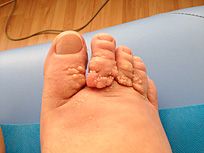Lymphoedema

Apart from the system of blood vessels, there is another network of vessels in the human body: it is called the lymphatic system and consists of lymphatic vessels, lymphatic nodes and lymphatic organs. Lymph secreted in the tissues is transported through the lymphatic system and the major lymphatic branches to the venous system. Lymphatic movement is triggered by the pressure of tissue fluids, active contractions of lymph vessel walls as well as pressure from adjacent organs and muscles. Lymph creates direct communication between the cells and the blood.
Under normal conditions, lymph production and lymph drainage are in balance. Normal immune function depends, for the most part, on the lymphatic system. Two to four litres of excess water, proteins, dead cells, foreign bodies and fat are drained from the connective tissue. If this filtering function is impaired, the body will not be able to get rid of the accumulated wastes, the immune system will not be able to fight the increasing load, thus giving rise to recurrent infections. The net result is an impaired and vulnerable immune system.
If the vessels are no longer able to drain the lymph, which is produced from the interstitial fluid, persistent oedema may develop .
Oedema: Accumulation of abnormal quantities of fluid in the intercellular space in the tissues or in a body cavity, caused by inflammation, impaired or overloaded venous or lymphatic circulation, heart failure or impaired renal function. It occurs most frequently in the loose connective tissue under the skin.
A solution to lymph oedema is drainage therapy, focusing on maintenance of the lymphatic and venous circulation and drainage of accumulated oedemas. Lasting results are achieved by manual or mechanical lymph drainage (maintenance treatment for 1-3 times a week), supported by the use of medical stockings, depending on the status achieved
The severity of lymphoedema ranges from a mild swelling of the feet resolving spontaneously on rest to elephant's foot.
Lymphoedemas are divided into three sub-types according to origin
Primary or congenital lymphoedema
Cause: the lymph vessels have not developed properly during foetal life.
Secondary or acquired lymphoedema
Causes:
- surgery, tumour irradiation
- injury, trauma
- inflammation
- severe lack of exercise, immobility
- chronic venous insufficiency
Mixed forms:
- excessive fat deposits - lipo-oedema
- oedemas of vascular origin - phlebo-oedema
- oedemas of cardiac, renal or thyroid origin
Major clinical symptoms of lymphoedema
Indicated syndactilia at toes II-III
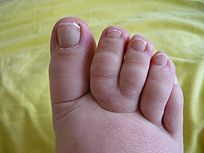
Sausage fingers or toes on the hands or feet
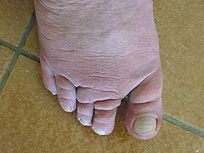
Loaf-like swelling of the hands or feet
Asymmetry: limbs of different thickness
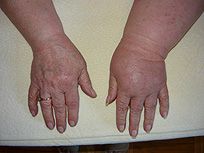
Hard, thick, pastry-like swelling
Infantile wrinkles at the base phalanges, wrists or ankles
Orange peel appearance
as a result of oedema, the skin is retracted around the hair follicles
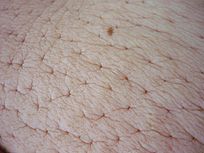
Stemmer-sign positivity
reduced creasibility of the skin, due to oedema
Papillomatosis
cauliflower growths, usually on the toes
